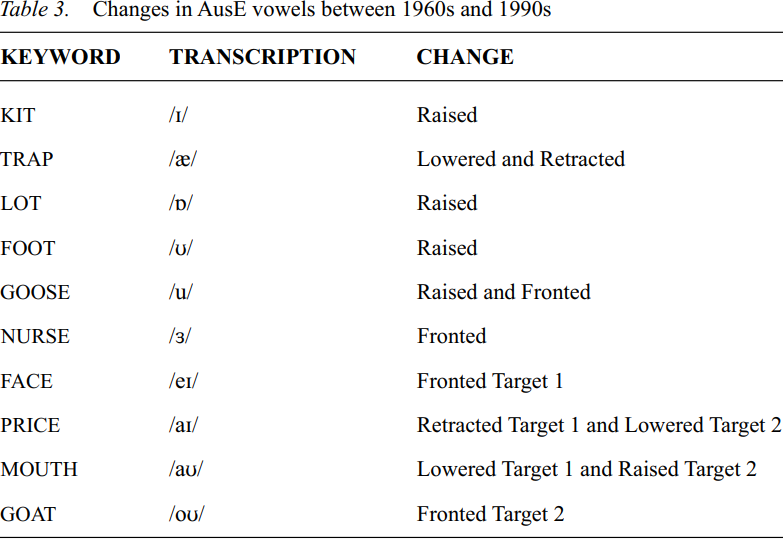


 Grammar
Grammar
 Tenses
Tenses
 Present
Present
 Past
Past
 Future
Future
 Parts Of Speech
Parts Of Speech
 Nouns
Nouns
 Verbs
Verbs
 Adverbs
Adverbs
 Adjectives
Adjectives
 Pronouns
Pronouns
 Pre Position
Pre Position
 Preposition by function
Preposition by function 
 Preposition by construction
Preposition by construction
 Conjunctions
Conjunctions
 Interjections
Interjections
 Grammar Rules
Grammar Rules
 Linguistics
Linguistics
 Semantics
Semantics
 Pragmatics
Pragmatics
 Reading Comprehension
Reading Comprehension|
Read More
Date: 2023-06-15
Date: 2024-03-19
Date: 2024-03-26
|
A number of phonological changes have been studied since the descriptions of AusE by Mitchell and Delbridge and Bernard first appeared. Cox and Palethorpe (2001: 25–29) compared their acoustic study of vowels collected from a group of men during the 1990s with a similar acoustic study reported by Bernard (1970) who collected his data in the 1960s, also from males. The summary of the changes are shown in Table 3. They note that these changes follow patterned relationships. The raised second target of the MOUTH vowel follows the raised LOT vowel and the fronted second target of the GOAT vowel follows the fronted GOOSE vowel. The fronted GOOSE and NURSE vowels represent a parallel shift and raised LOT and FOOT provide an example of a change shift.

The variation in the pronunciation of the GOAT vowel is of particular interest. Mitchell and Delbridge were the first to comment on the unusual behaviour of this vowel in their survey of adolescents in the 1960s. “A curiously variable glide is heard in the South Australian recordings. It ranges from  and from [ɔʊ] to [ɒy]. This group of sounds is the only one that emerged from our survey which seemed to be regionally distinctive” (Mitchell and Delbridge 1965: 84). Cox and Palethorpe (2001: 40) indicate that for their Sydney speakers, the first target has shifted toward [ɔ] and the upward glide is quite fronted, approaching [y] before /d/.
and from [ɔʊ] to [ɒy]. This group of sounds is the only one that emerged from our survey which seemed to be regionally distinctive” (Mitchell and Delbridge 1965: 84). Cox and Palethorpe (2001: 40) indicate that for their Sydney speakers, the first target has shifted toward [ɔ] and the upward glide is quite fronted, approaching [y] before /d/.
|
|
|
|
دراسة يابانية لتقليل مخاطر أمراض المواليد منخفضي الوزن
|
|
|
|
|
|
|
اكتشاف أكبر مرجان في العالم قبالة سواحل جزر سليمان
|
|
|
|
|
|
|
اتحاد كليات الطب الملكية البريطانية يشيد بالمستوى العلمي لطلبة جامعة العميد وبيئتها التعليمية
|
|
|